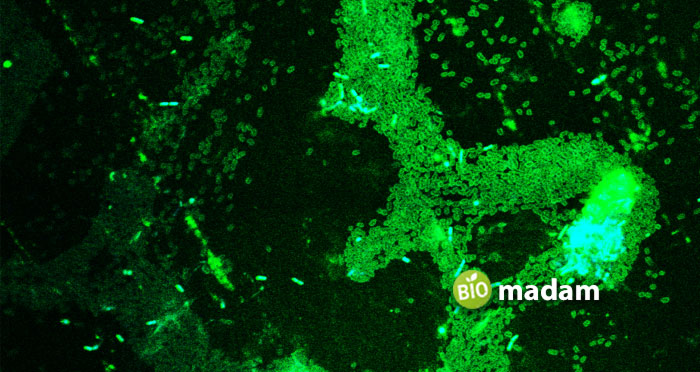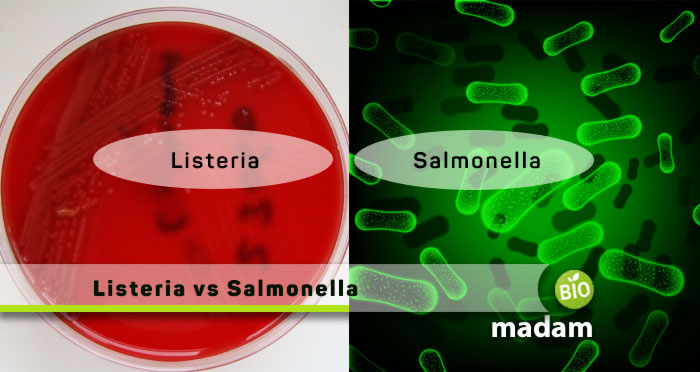Recently updated on February 7th, 2024 at 05:30 am
Listeria and salmonella are gram-positive and gram-negative bacteria that cause infections in human beings. The main difference between listeria and salmonella is in their cell wall. Listeria is a gram-positive genus, while salmonella is gram-negative bacteria. They typically contaminate food and cause gastric diseases. These infections and diseases can be fatal if not attended to in time.
Let’s tell you about all the differences between listeria and salmonella in detail.
Comparison Table
| Factors | Listeria | Salmonella |
| Bacteria | Gram-positive | Gram-negative |
| Species | 21 | 2 |
| Common Pathogen | Listeria monocytogenes | Salmonella enterica |
| Per Year Prevalence | 1,600 | A million |
| Deaths | 260 | 420 |
| Diseases | Gastroenteritis, encephalitis, meningitis, sepsis, & miscarriages | Paratyphoid, typhoid, and gastroenteritis |
| Symptoms | Headache, stiffness in the neck, confusion, loss of balance, etc. | Fever, headache, cramps, nausea, vomiting, and diarrhea or bloody stool |
| Risk Factors | Older adults, pregnant women, and immunocompromised people | Antacid use, sickle cell anemia, bowel disease, low immunity, age above 65 and below 5, etc. |
| Treatment | antibiotics | antibiotics, and IV fluids |
| Prevention | Avoid outside products, frozen food above 5 days | Interacting with animals, using dirty restrooms, etc. |
What is Listeria?
Listeria is the name of a bacteria genus, including different strains that contaminate food and may lead to listeriosis. Listeriosis is a potentially life-threatening condition caused by the intake of food contaminated with Listeria monocytogenes. It can grow at refrigeration temperatures where most bacteria denature.
Thus, the ability of the bacteria to withstand cold conditions increases their chances of survival. Listeria is present almost everywhere, including soil, water, and air sometimes. Yet, not many people get listeria.
Do You Know Why?
Because only a few listeria cannot cause a bacterial infection. People get infected only when listeria is present in thousands and millions on contaminated foods. Cooking kills bacteria, further reducing the chances of contamination.
Listeria usually resides in ready-to-eat foods that you do not cook. Common examples include unpasteurized dairy, soft cheese, sprouts, smoked meat, etc. Leaving food out at room temperature, like chicken and dairy, may facilitate the growth of listeria.

Prevalence
Listeria occurrence is not very high, and around 1,600 cases are reported annually. However, failure to diagnose and treat it in time may cause death. 260 people out of the 1,600 lose their lives due to the infection.
Listeria Infection Duration
The symptoms of listeria may appear as soon as a few hours after infection or may take up to 30 days. Sometimes, the condition resolves on its own in a few days. Other times, serious cases of listeriosis comprising encephalitis, meningitis, and blood infection may take as long as three months.
Symptoms
While listeria infection can be life-taking, it might not always show signs and symptoms immediately. Healthy people, especially, may recover on their own without experiencing severe listeria indicators. They might only feel flu-like symptoms such as stomachache, fever, and diarrhea lasting up to five days.
Yet, older adults and people with weak immunity may have other signs of listeria that they must report to a doctor. These are:
- Headache
- Stiffness in neck
- Convulsions
- Loss of balance
- Confusion
- Fever above 100.6° Fahrenheit/38° Celsius in pregnant women
Risk Factors
While listeria can infect anyone if ingested through food, a few groups are at a higher risk of infection. These include:
- Older people
- Pregnant women
- Individuals with weak immunity
Treatment of Listeria
Listeria is a serious infection and requires adequate treatment with antibiotics for recovery. Doctors generally prescribe high doses of antibiotics, but these can then cause constipation. Some antibiotics include penicillin, ampicillin, amoxicillin, and gentamicin. You may also need hospital care in case of a severe infection.
Prevention
It is quite easy to protect yourself from listeria as you can easily avoid consuming contaminated food. Here are a few tips to help you prevent listeria:
- Avoid consumption of ready-to-eat uncooked food
- Do not leave cut fruits uncovered outside
- Refrigerate anything you do not plan to eat immediately
- Cook or warm the meat products before consumption
- Do not consume anything sitting in your fridge uncovered for more than five days
- Wash your hands and utensils properly when handling meat
- Make sure not to cross-contaminate food
What is Salmonella?
Salmonella is a name we have heard quite widely in relation to meat and meat products. It is a genus of gram-negative bacteria that affects the intestinal tract. Salmonella bacteria enter our body by ingesting contaminated water or food, particularly meat. Salmonella also lives in animal intestines, where the bacteria act as a parasite. Salmonella may spread beyond the intestines, leading to life-threatening complications. Infection with salmonella restricts the small intestine’s ability to absorb water, resulting in a watery stool (diarrhea).
You may transmit salmonella from frozen foods, packaged meats, peanut butter, and animals such as guinea pigs, chickens, turtles, hedgehogs, etc.

Prevalence
Salmonella is the most common bacterial food poisoning in the US. The number of salmonella cases in the US is huge compared to listeria. Out of the millions affected in the US, around 26,500 people get hospitalized because of the severity of the infection. Almost 420 people die every year because of salmonella.
Symptoms of Salmonella
Most people infected with salmonella exhibit symptoms 8 to 12 hours after the exposure, while others may not show any signs at all. Healthy individuals recover without any particular treatment. The symptoms may all appear at once, or only a few might be present. The symptoms are typically not severe, yet they must be addressed immediately. Common symptoms of salmonella are:
- Fever
- Headache
- Stomachache
- Cramps
- Nausea
- Vomiting
- Diarrhea or bloody stool
Risk Factors
Salmonella is one of the most common infections surrounding our communities and ecosystems due to its wide presence in all environments. Thus, every individual is at salmonella risk. However, some people are at a higher risk than others. Risk factors for salmonella include:
- People who take antacids or recently completed an antibiotic course
- Individuals with inflammatory bowel disease
- Children under the age of 5
- Older people over the age of 65
- People who work around high-risk animals like guinea pigs, chickens, turtles, and ducks
- Immunocompromised individuals due to an underlying disease or disorder
- Patients with sickle cell anemia
Treatment of Salmonella
The treatment of salmonella is similar to listeria as they both are bacterial infections. However, the first line of treatment for salmonella includes IV fluids to retain body electrolytes lost because of diarrhea. In case the infection is severe, your doctor may prescribe you the following antibiotics:
- Ceftriaxone
- Ciprofloxacin
- Azithromycin
- Trimethoprim-sulfamethoxazole (TMP/SMX)
Sometimes, you may need intensive care at a hospital if your body does not respond to medicines.
Prevention of Salmonella
You can prevent salmonella by ensuring you keep your hands and food contamination-free from bacteria. Here are a few ways to make sure you are safe from salmonella:
- Wash your hands before eating, cooking, or handling food.
- Cook meat thoroughly to kill bacteria (if any).
- Don’t cook for others when you are sick.
- Always wash your hands after you handle meat to avoid contaminating other foods.
- Refrigerate seafood like salmon and poultry immediately.
- Avoid drinking water from unclean sources.
- Clean your hands with soap and water handling farm animals.
- Children younger than 5 years and adults older than 65 should not touch high-risk animals.
- Keep your pet cage or shed clean.
Similarities Between Listeria and Salmonella
- Listeria and salmonella are disease-causing bacteria.
- They affect your GI tract.
- They are intracellular pathogens.
- Listeria and salmonella are facultative anaerobes.
- They can be treated with antibiotics.
Differences Between Listeria and Salmonella
Definition
Listeria
Listeria is a gram-positive bacteria genus causing gastrointestinal diseases in humans.
Salmonella
On the contrary, salmonella is a genus of gram-negative bacteria affecting the intestines.
Species
Listeria
This type of genus contains 21 species of bacteria.
Salmonella
Contrarily, salmonella is a smaller genus with only 2 bacterial species.
Common Pathogens
Listeria
Listeria monocytogenes is the most common infective agent of the genus, causing listeriosis.
Salmonella
On the contrary, salmonella enterica causes Salmonellosis in humans.
Prevalence
Listeria
1,600 cases of listeria are reported in the US every year, with around 260 deaths.
Salmonella
Conversely, salmonella infects around a million people in the US annually. 26,500 of these patients end up in hospital while 400+ lose their lives.
Caused Diseases
Listeria
Listeria causes gastroenteritis, encephalitis, meningitis, sepsis, and miscarriages.
Salmonella
Whereas salmonella infection leads to paratyphoid fever, typhoid fever, and gastroenteritis.
Symptoms
Listeria
Listeriosis symptoms include headache, neck stiffness, convulsions, confusion, loss of balance, and a 100.6 or higher fever in pregnant women.
Salmonella
At the same time, fever, headache, stomachache, cramps, nausea, vomiting, and diarrhea or bloody stools indicate salmonella infection.
Risk Factors
Listeria
Old people, pregnant women, and immunocompromised individuals are at a higher risk of listeriosis through listeria.
Salmonella
On the contrary, certain medications like antacids increase the risk of salmonella. Other risk factors include sickle cell anemia, inflammatory bowel disease, low immunity, and age above 65 and below 5.
Treatment
Listeria
Doctors typically prescribe penicillin, ampicillin, amoxicillin, and gentamicin to treat listeria.
Salmonella
Alternatively, salmonella requires immediate IV to replenish fluids followed by antibiotics like ceftriaxone, ciprofloxacin, azithromycin, and trimethoprim-sulfamethoxazole (TMP/SMX).
Prevention
Listeria
Avoiding ready-to-eat food and cooking meat products properly can prevent listeria contamination. It is also advised not to eat anything left uncovered in the fridge for over 5 days.
Salmonella
Moreover, you can avoid salmonella infection by washing your hands thoroughly after handling meat stored in fridge or outside, avoiding drinking water from unclean sources, and avoiding high-risk animals like chickens, ducks, guinea pigs, etc.
The Bottom Line
Listeria and salmonella are disease-causing bacteria that harm the gastrointestinal tract. They both contaminate food and lead to headaches, stomachache, and diarrhea. Salmonella is more prevalent than listeria and infects around a million people in the US every year. The main difference between listeria and salmonella is the difference in their staining. Listeria is gram-positive, while salmonella is gram-negative bacteria. Despite distinct symptoms and causes, you can prevent infection by cooking your food properly and keeping it in the fridge covered.

Anna has completed her degree in Pharmacy from the University of Hawaii. She is serving as a research assistant in a pharmaceutical company. She had a great interest in writing blogs, traveling to different parts of the US, and trying delicious recipes in her spare time.

